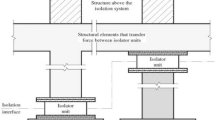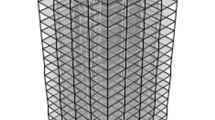Abstract
Seismic uncertainties pose response estimation procedures with serious concerns about proper reflection of ground motion intensity measure (IM) and reasonable scaling of IM in a scenario-based study. The extent of response variability due to these uncertainties is quantified in this article for steel moment-resisting frames (SMRFs). For this purpose, three 3-, 7-, and 15-story SMRFs are designed and nonlinearly modeled in OpenSees Program. To establish an initial collection of building responses in a diverse range of intensities and for multiple ground motion records, incremental dynamic analysis is performed using a set of 44 records. At the initial phase, the efficiency of two well-known IMs, i.e., peak ground acceleration (PGA) and first-mode spectral acceleration Sa (T1), is re-evaluated for the studied structures. This is achieved by quantifying the dispersion of building response data at different levels of behavior nonlinearity. The dispersion of response data caused by PGA is shown to reach 1–13 times of the Sa’s where the 1 ratio is related to the linear response range of the shortest 3-story structure and the 13 ratios reflect the collapse response of the 15-story structure. Afterwards, scatter of building responses extracted using different number of acceleration records and various intensity scaling methods is evaluated. The dispersion of the response data shows clear correlation to the selected scaling method whereas using larger suites of records does not necessarily lead to a decrease of the data dispersion.



















Similar content being viewed by others
References
Alavi, B., & Krawinkler, H. (2000). Consideration of near-fault ground motion effects in seismic design. In Proceedings of the 12th World Conference on Earthquake Engineering (p. 8).
American Institute of Steel Construction Inc. (2005). Seismic provisions for structural steel buildings. Chicago, IL: ANSI, AISC 341-05.
American Society of Civil Engineers. (2010). Minimum design loads for buildings and other structures. Reston: ASCE 7-10.
American Society of Civil Engineers, Reston, Virginia. (2016). Minimum design loads and associated criteria for buildings and other structures. Reston: ASCE 7-16.
Ansi, B. (2005). AISC 360-05-specification for structural steel buildings. Chicago: AISC.
Applied Technology Council. (2009). Quantification of building seismic performance factors. Washington, DC: US Department of Homeland Security, FEMA.
Bazzurro, P. (1998). Probabilistic seismic demand analysis. Stanford University.
Berman, J. W. (2011). Seismic behavior of code designed steel plate shear walls. Engineering Structures, 33(1), 230–244.
Clayton, P. M., Berman, J. W., & Lowes, L. N. (2011). Seismic design and performance of self-centering steel plate shear walls. Journal of Structural Engineering, 138(1), 22–30.
Clayton, P. M., Berman, J. W., & Lowes, L. N. (2015). Seismic performance of self-centering steel plate shear walls with beam-only-connected web plates. Journal of Constructional Steel Research, 106, 198–208.
Code, U. B. (1997). UBC-97. In Structural engineering design provisions. International Conference of Building Officials, Whittier, California.
Gerami, M., & Sivandi-Pour, A. (2014). Performance-based seismic rehabilitation of existing steel eccentric braced buildings in near fault ground motions. The Structural Design of Tall and Special Buildings, 23(12), 881–896.
Hamburger, R., Rojahn, C., Heintz, J., & Mahoney, M. (2012). FEMA P58: Next-generation building seismic performance assessment methodology. In Fifteenth World Conference on Earthquake Engineering, Lisbon, Portugal.
Jalali, S. A., & Banazadeh, M. (2016). Development of a new deteriorating hysteresis model for seismic collapse assessment of thin steel plate shear walls. Thin-Walled Structures, 106, 244–257.
Jalali, S. A., Banazadeh, M., Abolmaali, A., & Tafakori, E. (2012). Probabilistic seismic demand assessment of steel moment frames with side-plate connections. Scientia Iranica, 19(1), 27–40.
Jalali, S. A., Banazadeh, M., Tafakori, E., & Abolmaali, A. (2011). Seismic performance assessment of steel moment frames with generic locally reinforced connections. Journal of Constructional Steel Research, 67(8), 1261–1271.
Kalkan, E., & Chopra, A. K. (2010). Practical guidelines to select and scale earthquake records for nonlinear response history analysis of structures. US Geological Survey Open-File Report, 1068, 126.
Kurama, Y. C., & Farrow, K. T. (2003). Ground motion scaling methods for different site conditions and structure characteristics. Earthquake Engineering and Structural Dynamics, 32(15), 2425–2450.
Luco, N., & Cornell, C. A. (2007). Structure-specific scalar intensity measures for near-source and ordinary earthquake ground motions. Earthquake Spectra, 23(2), 357–392.
Masaeli, H., Khoshnoudian, F., & Musician, S. (2018). Incremental dynamic analysis of nonlinear rocking soil–structure systems. Soil Dynamics and Earthquake Engineering, 104, 236–249.
Mazzoni, S., McKenna, F., Scott, M. H., & Fenves, G. (2004). OpenSees users manual. PEER, University of California, Berkeley, 18, 56–57.
Miranda, E. (1993). Evaluation of site-dependent inelastic seismic design spectra. Journal of Structural Engineering, 119(5), 1319–1338.
Nau, J. M., & Hall, W. J. (1984). Scaling methods for earthquake response spectra. Journal of Structural Engineering, 110(7), 1533–1548.
Shome, N. (1999). Probabilistic seismic demand analysis of nonlinear structures. Stanford: Stanford University.
Shome, N., & Cornell, C. A. (1998). Normalization and scaling accelerograms for nonlinear structural analysis. In Proceedings of the 6th US National Conference on Earthquake Engineering (pp. 1–12). Seattle.
Shome, N., Cornell, C. A., Bazzurro, P., & Carballo, J. E. (1998). Earthquakes, records, and nonlinear responses. Earthquake Spectra, 14(3), 469–500.
Sivandi-Pour, A., Gerami, M., & Kheyroddin, A. (2015). Determination of modal damping ratios for non-classically damped rehabilitated steel structures. Iranian Journal of Science and Technology. Transactions of Civil Engineering, 39(C1), 81.
Sivandi-Pour, A., Gerami, M., & Khodayarnezhad, D. (2014). Equivalent modal damping ratios for non-classically damped hybrid steel concrete buildings with transitional storey. Structural Engineering and Mechanics, 5(3), 383–401.
Soleimani, S., Aziminejad, A., & Moghadam, A. S. (2018). Approximate two-component incremental dynamic analysis using a bidirectional energy-based pushover procedure. Engineering Structures, 157, 86–95.
Standard No. 2800. (2014). Iranian code of practice for seismic resistant design of buildings (4th ed.).
Vamvatsikos, D., & Cornell, C. A. (2002). Incremental dynamic analysis. Earthquake Engineering and Structural Dynamics, 31(3), 491–514.
Venture, N. C. J. (2011). Selecting and scaling earthquake ground motions for performing response-history analyses (pp. 11–917). NIST GCR.
Author information
Authors and Affiliations
Corresponding author
Ethics declarations
Conflict of interest
The authors state that there is no conflict of interest in this research.
Additional information
Publisher's Note
Springer Nature remains neutral with regard to jurisdictional claims in published maps and institutional affiliations.
Rights and permissions
About this article
Cite this article
Norouzi, A.H., Gerami, M. Quantifying response variability of steel moment frames due to seismic uncertainties. Asian J Civ Eng 20, 503–514 (2019). https://doi.org/10.1007/s42107-019-00115-3
Received:
Accepted:
Published:
Issue Date:
DOI: https://doi.org/10.1007/s42107-019-00115-3




